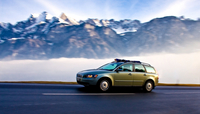Skiers Cut Accident Risk by Driving Abroad on Safe Tyres
LONDON – January 15, 2009: When heading to European skiing destinations, motorists should ensure they use correctly inflated tyres with sufficient tread depth to perform on icy, snow-covered roads.
British skiers driving to Europe can significantly reduce the risk of an accident by making sure their tyres are safe to tackle sub-zero weather conditions. During the 2007-08 season, over 175,000 skiers travelled to their holiday destination by car. Skiers risk an abrupt end to their trip if driving heavily laden cars with incorrect tyre pressures or low tread depth on icy, snow-covered roads.
“Driving in snowy mountain regions requires a good level of tread depth to maintain traction with the road and stay in control of the vehicle,” comments TyreSafe chairman Rob Beddis. “In certain European countries it is a legal requirement to fit cold weather tyres. British holidaymakers should be careful to check the legislation of their destination country and any they drive through on the way there before leaving, in order to avoid costly penalties or invalidating their insurance.”
Popular skiing destinations such as France, Austria, Germany and Italy all recommend the use of cold weather tyres, while in Scandinavia cold weather tyres are recommended in Norway and Sweden, and mandatory in Finland from 1st December to 1st March. Cold weather tyres contain a higher quantity of natural rubber compound, which allows them to retain their flexibility on frozen roads. They also contain many tiny cuts in the tread which help the tyre to absorb snow, rather than slide over it. Whether driving on normal, ‘summer’ tyres or cold weather tyres, making sure that the tyre has a sufficient amount of tread depth is fundamental to braking and driving safely on wet and icy roads.
“Checking the tyre pressure for their vehicle when fully laden is also an important consideration when driving to a ski resort, as it may be necessary to increase the pressures to support the increased load of the vehicle,” continues Beddis. “Many motorists neglect to adjust their tyre pressures to take account of heavy skiing equipment and extra passengers, which can lead to a build-up of heat inside the tyre as it strains to perform under the additional weight. This could eventually result in a blowout, putting themselves, passengers and other road users at risk.”
Further advice regarding legal requirements when driving abroad in cold weather can be found on the Foreign and Commonwealth Office website, while details of the manufacturer’s recommended tyre pressure can be found in the owner’s manual, inside the fuel filler cap, or on the inner sill. For further information on tyre safety or cold weather tyres, please visit www.tyresafe.org.



